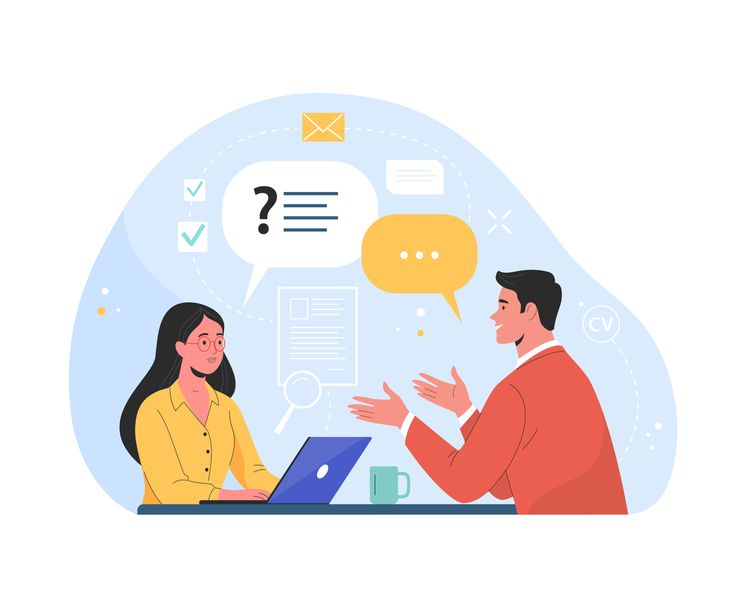
On today’s blog post….
Hello and welcome to my second blog post! Today I will be reflecting on my experience regarding the AEL3001 Work-Based Learning stimulated interviews. I’m now an expert but I hope this blog post makes you feel less terrified for having to go through the interview process for any job because although it is very daunting, it’s actually not that scary as you may think, especially when you can reflect on how well you done and what you need to improve on afterwards.
Throughout this blog post I will be discussing my chosen job role for my simulated interview which was a radio host position based in Q Radio! This is something that I would love to do after I finish my degree so I figured that if I had practice now, then I could prefect it for when or if I ever sit an interview to be a radio host. So, shall we get into this?
The step-by-step guide to a successful interview
- Pick your job (and manifest that you move onto the next step).
- You’ve made it to the second step, CONGRATULATIONS. Time to impress your interviewer and research everything you know about this company.
- The third step is something I like to call the ‘learning curve’ – If you have went through the interview process before, this is a time to remember what NOT to do for your next interview.
- Using Borton’s Model of Reflection (1970) it’s time to reflect on your strengths and weaknesses during your interview.
Borton’s Model of Reflection (1970): Why should you use it?
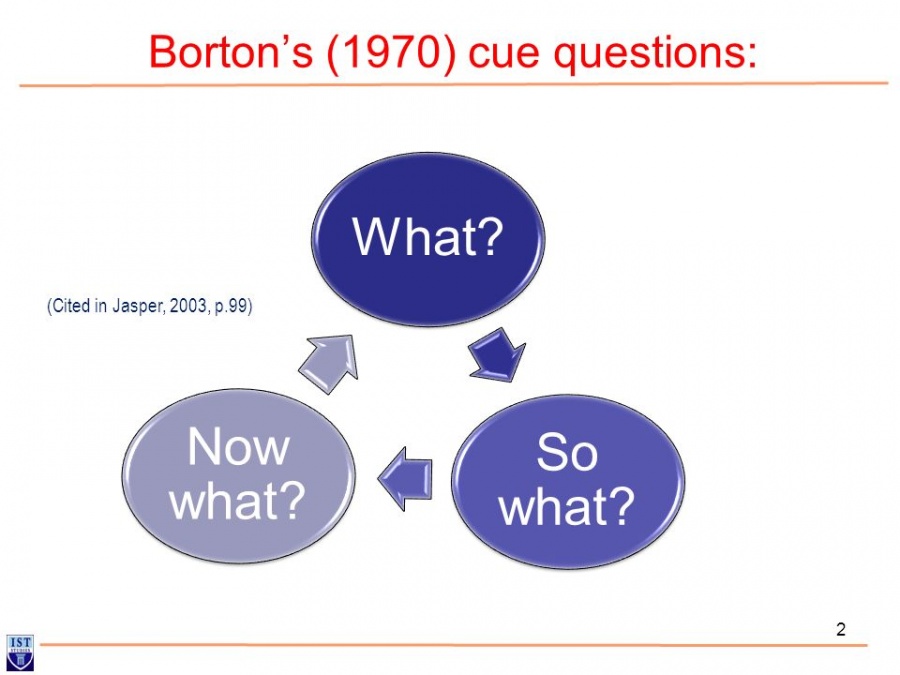
Borton’s Model of Reflection is a great framework as it “presents a relatively simple model” and it “can be used at different levels as students become more adept at reflecting on their practice” (Jasper, 99). As I am undertaking my AEL3001 Work-Based Leaning module core skills are at the heart of the module with some of them being able to “have the ability and desire to learn for oneself and improve one’s self-awareness and performance” and to also “reflect on and evaluate own practice” (AEL3001 Handbook), therefore enabling me to complete some of my learning outcomes within the module. With Borton’s reflection model having just three steps, it makes it less confusing, therefore it’s more effective as these three questions really stuck with me after my interview and seemingly making my reflection easier as I was able to break it down, step by step.
Step 1: What?
The first step of Borton’s model is the ‘What’ stage which is all about self-awareness – this is all about YOU! I know it’s time to be self-centred. All questions around this stage forms around the word ‘What’ and in figure three some examples of this stage include “What happened, what was I doing? and what were others doing?” (Rolfe 2001).
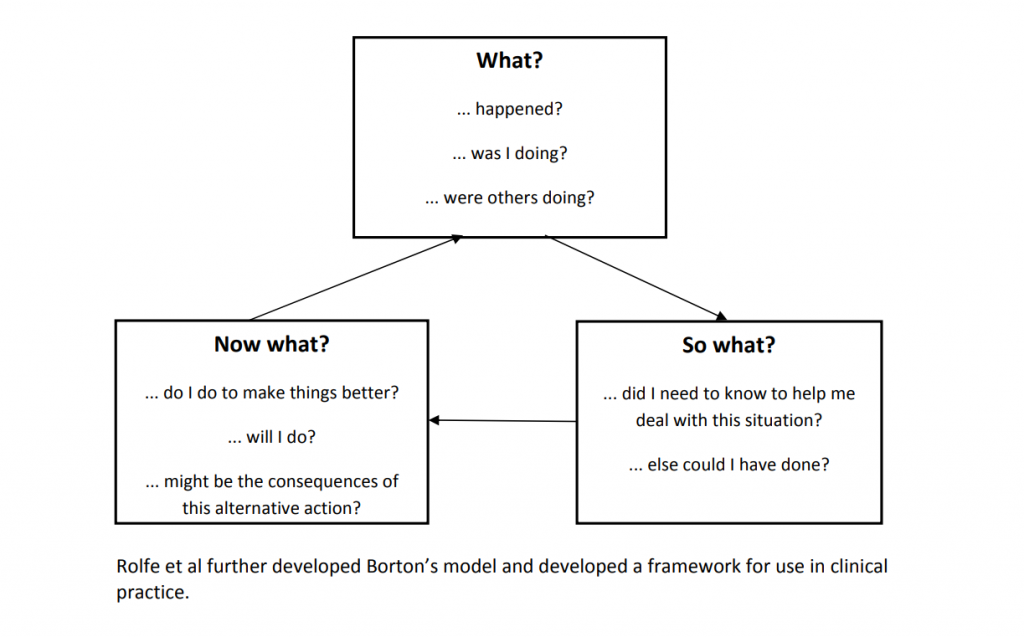
With this in mind, we found out our date for our simulated interview in well advance to help us feel prepared, which for my course (Broadcast Production), our interviews would be held on the 8th of February 2024. My initial reaction when I found out our date was to just forget about it and worry about it until two days before as it wasn’t a proper interview, however the more I thought about it, the more I realised that I should actually put some work into this to help me practice.
As mentioned in my step-by-step guide, I acknowledge that research is a vital part of the interview process as it not only impresses your interviewer, but it indicates to them that you are “interested in the organisation” and that you have a desire for the job, thus “showing enthusiasm” (Jay, 21). With this is mind, I researched Q Radio as a whole and then I looked at their job description to get a clear indication of what they were looking for. By doing this I was able to prepare myself for any questions which may be asked such as, “What skills or qualities do I have?”, and with the information shown in figure four I would be able to state ones which applies to me, therefore showing that I have done my research. When I was reading about job interviews a quote from Nicolas Roulin stated that females are typically good a using different “coping strategies to manage anxiety” such as “sharing one’s anxiety with others, such as friends or family members, before the event” – This is known as “emotion coping” (56).
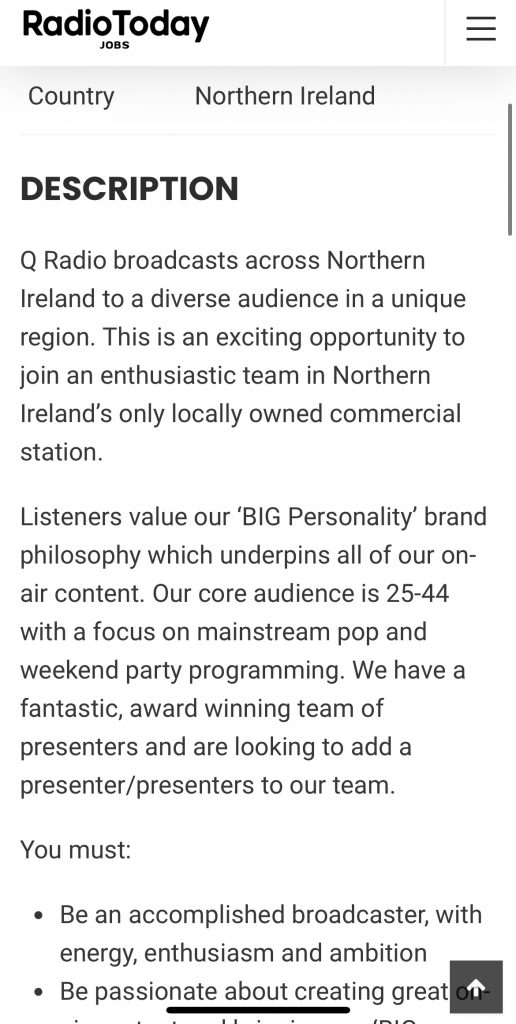
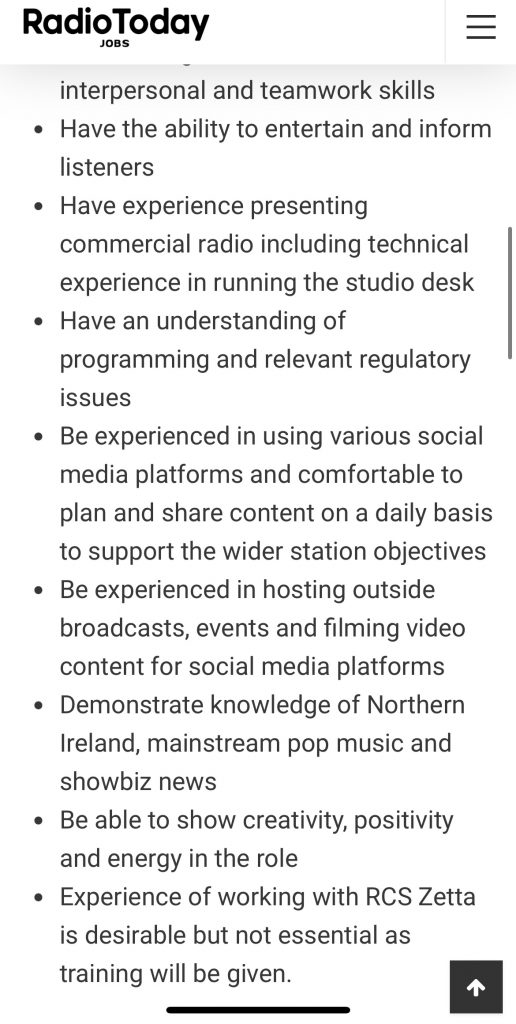
Figure four – Source: Radio Today Jobs
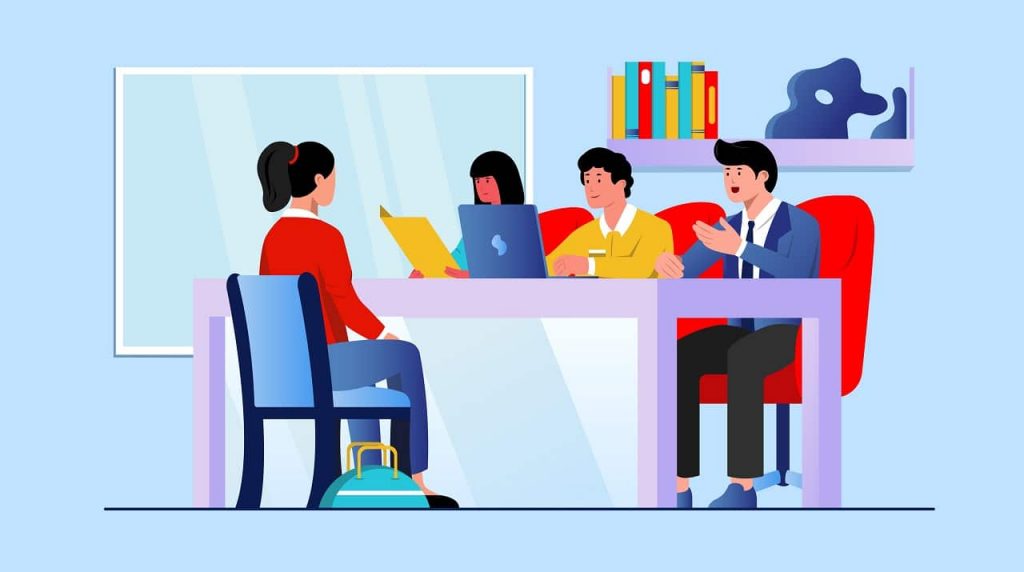
Fast forward it to interview day. It was a cold and wet morning on the streets of Belfast which was nothing new. My nerves were kicking in as I was walking to our interview room as I knew that the style of our interview was going to be a panel and if you thought having to do a 1-1 interview was nerve wrecking, then I hate to break it to you a panel is absolutely worse. Before I left the house my mum gave me a pep talk which helped a lot to keep me calm – Thanks Roulin for that tip!
Step 2 and Step 3: The So What? And Now What? stage
Furthermore, the ‘So What?’ and the ‘Now What” stages are kind of similar which is why I have just created one section for this, but don’t worry I’m about to delve into both of them in detail. The ‘So What?’ questions are usually along the lines of “So what could I have done that was different?” (Jasper, 100). This stage is known as the “knowledge-building stage” in which you help to improve your “self-improvement” (Robinson). Whereas the ‘Now What?’ stage poses questions such as “Now what will I do?” and with this stage it “combines the processes of exploring alternatives and planning action that will be put into practice (Jasper,100).
I thought my simulated interview went well; however, I knew that I definitely messed up some parts of it such as being stumped on some of the questions and then forgetting to slow down which then led to me thinking about it during the day and becoming paranoid. We all overthink these things, right? We were given a feedback form which was broken down into three sections (content, reflection, and presentation) and instead of me being continuing to be self-critical, I decided to have a look at what my peers thought that my strengths were which you can see from this table.
| Content | Reflection | Presentation |
| “It was good that you spoke about previous employment experiencing highlighting that you have knowledge of the workplace & how to be a professional” | “Able to adapt the question to something they do know about – making more personable” | “Really good eye contact & generally visually engaging (gestures). Could be more formal in language” |
Remember when you were in school and you used to receive feedback on your assignments or behaviour, well this is how it felt. In fact, feedback forms can improve “self-efficacy” and “motivation” due to “when students have high self-efficacy and believe that their actions can produce the outcomes they desire, they are also motivated to act” (Bas T. Agricola, 8). The feedback from my peers really achieved what my previous point stated as it lifted my mood and indicated to me that I was in fact doing things right, however I knew that my nerves were getting the better of me as they pointed out that I could’ve been more formal in language. I guess I forgot that I wasn’t actually talking to an actual employer so therefore I just used language that my peers were comfortable with, almost as if we were having a normal conversation
Using figure three from Rolfe, this simulated interview has prepared me and help me to acknowledge what my strengths and weaknesses are and thus, when I go for an interview in real life, I will know exactly what to focus on such as using formal language and staying calm. With practice I feel as if I will be able to confidently show up to an interview and know exactly what to expect, but let’s face it, the nervous feeling will NEVER disappear. Anyway, I hope this blog post filled you with positivity and showed you that everyone goes through the same process of panicking and not knowing what to do after an interview. We’re all human, these things are scary and from what i’ve learnt if you just go in and be yourself (and of course be professional) then that’s all you really can do.
Thanks so much for reading and good luck for your next interview I’m signing off now!
Jessica Orr
Work cited
Agricola, Bas T. & Prins, Frans J. et al, Impact of feedback request forms and verbal feedback on higher education students’ feedback perception, self-efficacy, and motivation, Routledge, 2019, pp6-25
Doyle, Alison. “The Worst Job Interview Answers”, The Balance, 2021, https://www.thebalancemoney.com/worst-interview-answers-2061232 , Date Accessed 04/03/2024
“Guide To Ace Your Panel Interview (Questions + Tips)”, Big Interview, https://resources.biginterview.com/interviews-101/panel-interview/ , Date Accessed 04/03/2024
Jasper, Melanie. “Ch 3: Frameworks for Reflection: Borton’s Developmental Framework”, Beginning reflective practice, 2nd ed, Cengage Learning, 2013, pp99-104.
Jay, Ros. “Chapter two: How to Prepare”, Brilliant interview: what employers want to hear and how to say it, 3rd ed, Prentice Hall, 2011, pp20-29.
Lee, Michelle. “Borton’s Development Framework”, Physiopedia, https://www.physio-pedia.com/Borton%27s_Development_Framework , Date Accessed 04/03/2024
“Q Radio Presenter”, Radio Today Jobs, November 30th, 2023, https://radiotodayjobs.com/job/q-radio-presenter
“Reflective practice”, BDA The Association of UK Dietitians, 2024, https://www.bda.uk.com/practice-and-education/education/cpd/reflective-practice.html , Date Accessed 03/03/24
Roulin, Nicolas. “Let the show begin: How to interview effectively from both sides of the table”, The psychology of job interviews, 2nd ed, Routledge, 2022
Robinson, Jessica. “All-inclusive Guide to Borton’s Reflective Model”, Crow Jack, 2022, https://crowjack.com/blog/strategy/reflection-models/borton-reflective-model , Date Accessed 03/03/2024